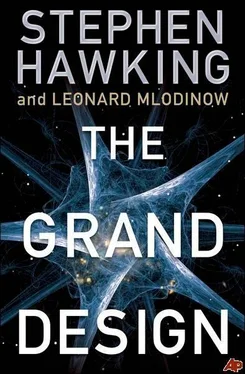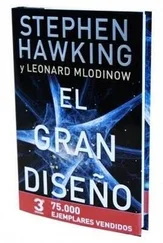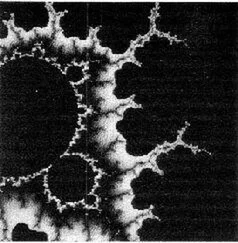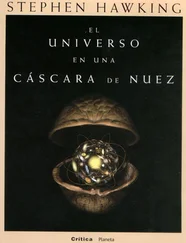Asymptotic freedom • a property of the strong force that causes it to become weaker at short distances. Hence, although quarks are bound in nuclei by the strong force, they can move within nuclei almost as if they felt no force at all.
Atom • the basic unit of ordinary matter, consisting of a nucleus with protons and neutrons, surrounded by orbiting electrons.
Baryon • a type of elementary particle, such as the proton or neutron, that is made of three quarks.
Big bang • the dense, hot beginning of the universe. The big bang theory postulates that about 13.7 billion years ago the part of the universe we can see today was only a few millimeters across. Today the universe is vastly larger and cooler, but we can observe the remnants of that early period in the cosmic microwave background radiation that permeates all space.
Black hole • a region of space-time that, due to its immense gravitational force, is cut off from the rest of the universe.
Boson • an elementary particle that carries force.
Bottom-up approach • in cosmology, an idea that rests on the assumption that there’s a single history of the universe, with a well-defined starting point, and that the state of the universe today is an evolution from that beginning.
Classical physics • any theory of physics in which the universe is assumed to have a single, well-defined history.
Cosmological constant • a parameter in Einstein’s equations that gives space-time an inherent tendency to expand.
Electromagnetic force • the second strongest of the four forces of nature. It acts between particles with electric charges.
Electron • an elementary particle of matter that has a negative charge and is responsible for the chemical properties of elements.
Fermion • a matter-type elementary particle.
Galaxy • a large system of stars, interstellar matter, and dark matter that is held together by gravity.
Gravity • the weakest of the four forces of nature. It is the means by which objects that have mass attract each other.
Heisenberg uncertainty principle • a law of quantum theory stating that certain pairs of physical properties cannot be known simultaneously to arbitrary precision.
Meson • a type of elementary particle that is made of a quark and an anti-quark.
M-theory • a fundamental theory of physics that is a candidate for the theory of everything.
Multiverse • a set of universes.
Neutrino • an extremely light elementary particle that is affected only by the weak nuclear force and gravity.
Neutron • a type of electrically neutral baryon that with the proton forms the nucleus of an atom.
No-boundary condition • the requirement that the histories of the universe are closed surfaces without a boundary.
Phase • a position in the cycle of a wave.
Photon • a boson that carries the electromagnetic force. A quantum particle of light.
Probability amplitude • in a quantum theory, a complex number whose absolute value squared gives a probability.
Proton • a type of positively charged baryon that with the neutron forms the nucleus of an atom.
Quantum theory • a theory in which objects do not have single definite histories.
Quark • an elementary particle with a fractional electric charge that feels the strong force. Protons and neutrons are each composed of three quarks.
Renormalization • a mathematical technique designed to make sense of infinities that arise in quantum theories.
Singularity • a point in space-time at which a physical quantity becomes infinite.
Space-time • a mathematical space whose points must be specified by both space and time coordinates.
String theory • a theory of physics in which particles are described as patterns of vibration that have length but no height or width-like infinitely thin pieces of string.
Strong nuclear force • the strongest of the four forces of nature. This force holds the protons and neutrons inside the nucleus of an atom. It also holds together the protons and neutrons themselves, which is necessary because they are made of still tinier particles, quarks.
Supergravity • a theory of gravity that has a kind of symmetry called supersymmetry.
Supersymmetry • a subtle kind of symmetry that cannot be associated with a transformation of ordinary space. One of the important implications of supersymmetry is that force particles and matter particles, and hence force and matter, are really just two facets of the same thing.
Top-down approach • the approach to cosmology in which one traces the histories of the universe from the “top down,” that is, backward from the present time.
Weak nuclear force • one of the four forces of nature. The weak force is responsible for radioactivity and plays a vital role in the formation of the elements in stars and the early universe.

THE UNIVERSE HAS A DESIGN, and so does a book. But unlike the universe, a book does not appear spontaneously from nothing. A book requires a creator, and that role does not fall solely on the shoulders of its authors. So first and foremost we’d like to acknowledge and thank our editors, Beth Rashbaum and Ann Harris, for their near-infinite patience. They were our students when we required students, our teachers when we required teachers, and our prodders when we required prodding. They stuck with the manuscript, and did it in good cheer, whether the discussion centered around the placement of a comma or the impossibility of embedding a negative curvature surface axisymmetrically in flat space. We’d also like to thank Mark Hillery, who kindly read much of the manuscript and provided valuable input; Carole Lowenstein, who did so much to help with the interior design; David Stevenson, who guided the cover to completion; and Loren Noveck, whose attention to detail has saved us from some typos we would not like to have seen committed to print. To Peter Bollinger: much gratitude for bringing art to science in your illustrations, and for your diligence in ensuring the accuracy of every detail. And to Sidney Harris: Thank you for your wonderful cartoons, and your great sensitivity to the issues facing scientists. In another universe, you could have been a physicist. We are also grateful to our agents, Al Zuckerman and Susan Ginsburg, for their support and encouragement. If there are two messages they consistently provided, they were “It’s time to finish the book already,” and “Don’t worry about when you’ll finish, you’ll get there eventually.” They were wise enough to know when to say which. And finally, our thanks to Stephen’s personal assistant, Judith Croasdell; his computer aide, Sam Blackburn; and Joan Godwin. They provided not just moral support, but practical and technical support without which we could not have written this book. Moreover, they always knew where to find the best pubs.

Air, discovery of
Almagest (Ptolemy)
Alternative histories. See also Quantum physics/quantum theory
Feynman diagrams and
Feynman’s sum over histories and
the past and
quantum vs. Newtonian worlds and
universe and
Anaximander
Anthropic principle
strong anthropic principle
weak anthropic principle
Antimatter
Anti-quarks (pi mesons)
Anti-realists
Apparent laws of nature
Aquinas, Thomas
Archimedes
Aristarchus
Aristotle
creation as deliberate design
four-element theory
Читать дальше














